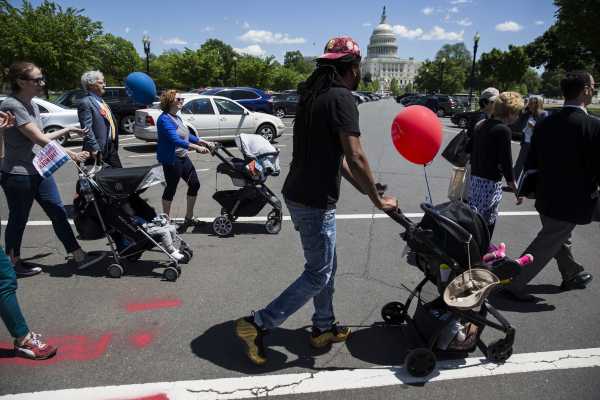
Republicans in Congress are trying to revive a flawed plan to give working parents paid maternity and paternity leave.
Sens. Joni Ernst (R-IA) and Mike Lee (R-UT) announced details of their proposal Tuesday, called the Cradle Act, which they describe as the best option for paid leave because it doesn’t create “a massive mandated government program.”
But the truth is, it’s not paid leave at all. It’s another version of unpaid leave that working parents in the United States would have to fund themselves.
Here’s how it would work: The Cradle Act would let workers access some of their Social Security retirement income in advance to make up for some of the wages they would lose when taking parental leave. Workers would still bear the cost of taking time off — by delaying their retirement by twice as many months as they took off for parental leave. Someone who takes the maximum three months off, for example, would need to delay their Social Security retirement by six months.
The bill is nearly identical to a bill Sen. Marco Rubio (R-FL) proposed last year, called the Economic Security Act for New Parents, with support from White House adviser Ivanka Trump. They didn’t get enough bipartisan support for it, so it went nowhere.
Now the GOP is trying to resurrect a slightly different version of the same plan, hoping it will satisfy the growing public demand for a federal paid leave program.
The United States is the only industrialized country that doesn’t guarantee paid parental leave to working parents, and Republicans and Democratic voters overwhelmingly support the creation of such a program. The problem is that no one seems to agree on how to pay for it, and Republicans don’t want to make businesses chip in.
Instead, the Cradle Act would raid the Social Security Trust Fund, which is already at risk of being depleted. Ernst and Lee say their plan will address that by moving money from other parts of the budget to cover the borrowed Social Security funds until they are repaid — a move that would likely expand the already ballooning budget deficit.
Americans want paid parental leave, and the US economy needs it
The idea of a government-run program to provide maternity and paternity leave to new parents is not controversial. About 74 percent of registered US voters in 2016 said the government should require businesses to offer employees paid parental leave. When you break down poll numbers, the support is overwhelming across genders, political parties, and even income groups. In other words, it’s a safe political issue for Republicans to tackle, if only they weren’t so hesitant to make businesses pay part — or all — of the cost.
Nearly every industrialized country in the world provides working mothers with at least three months of paid maternity leave — the minimum recommended by the United Nations’ International Labour Organization. In most of those countries, employers and employees pay a tax to fund the benefit. Canada has this type of system, which allows parents to take a year of leave while receiving 55 percent of their salary (up to 80 percent of wages are covered for low-income workers).
Some US businesses voluntarily offer paid parental leave to their workers, but only about one in 10 workers in the country get such a benefit from their employer. Low-wage workers are the least likely to get it.
In response to federal inaction on the issue, several states have started requiring employers to provide some paid leave: California, New York, and the District of Columbia are among those that do.
Research shows that paid leave programs improve child health, promote gender equality, and help keep women in the workforce. Studies indicate that California’s paid-leave law, which went into effect in 2004, led to an increase in work hours and income for mothers with young children. And paid leave has been linked to lower poverty rates in 18 countries.
The need for paid leave in the United States is more urgent than ever, as nearly half of two-parent US households with children have parents who both work full-time jobs. Economists believe the lack of paid leave is one reason more American women aren’t joining the labor force, and that’s bad news for the US economy (their labor force participation rate is not the same as their unemployment rate). About 58.9 percent of women over the age of 20 are part of the US workforce, reflecting a slight decline since 2008, when 61 percent held jobs.
When women joined the public labor force en masse in the 1970s, their earnings were a huge boost to the US economy, according to the White House Council of Economic Advisers under President Obama. They attributed nearly all of the middle-class income growth since 1970 to the rise of women entering the US workforce. But female participation in the job market began to flatten out in the 1990s, even among women in their prime working years (25 to 54 years old).
And nearly a third of the decline of American women in the labor force, in comparison to other developed countries, can be explained by the lack of family-friendly workplace policies in the United States, including paid leave for new parents, according to research by economists Francine Blau and Lawrence Kahn at Cornell University.
Coming up with an effective paid parental leave system in the United States isn’t hard. The hard part is getting Republicans to agree that businesses should pay for some of it. Which is how we get to Ernst and Lee’s shortsighted plan.
The Cradle Act could worsen the Social Security crisis
The GOP’s latest plan doesn’t include estimates of how much money working parents might end up borrowing from Social Security each year under the Cradle Act. But here’s what we know about it: New parents would dip into their Social Security retirement benefits to cover part of the cost of taking time off from work. They can’t replace 100 percent of their income — only a portion of it, depending on their income bracket.
Ernst and Lee say it’s designed so that the lowest-paid workers get the most coverage, up to about 75 percent of their wages covered for three months. However, that would mean delaying their retirement payments through Social Security six months per child if they take the maximum three months off. The benefit is not available for other types of paid leave, such as workers who need to take time off to care for a sick relative.
So in essence, it’s a “paid” plan that employers aren’t responsible for, since workers are the ones paying for their own time off.
In short, employers pay nothing, and neither does the federal government. The plan also doesn’t take into account the fact that the future of Social Security is in jeopardy. The system is running a deficit for the first time in more than 30 years, and the Social Security administration expects that it will run out of money to pay workers their full retirement benefits by 2035. Because working parents won’t be paying back the borrowed money until they retire decades from now, allowing workers to take more money from the system will only make the problem worse.
Ernst and Lee say the Cradle Act addresses this problem. Under the bill, lawmakers would transfer money each year from the government’s General Fund to replenish whatever parents borrowed from the Social Security Trust Fund. But it’s hard to see how this wouldn’t add to the deficit, as they claim, because there’s not a lot of unused money sitting around in the General Fund. If parents (hypothetically) borrow $2 billion in one year, that means Congress will need to find a way to pay for it, assuming lawmakers are serious about protecting Social Security.
Which brings me to this fact: There are other options out there.
A group of influential conservative and liberal economists proposed one not-so-ideal option in 2017: pay for parental leave by increasing payroll taxes on workers and through other savings in the federal budget. The downside is that the plan still lets businesses off the hook from shouldering any of the cost.
Sharing the cost between employees and businesses seems obvious. That’s how most workers insurance programs operate, and that’s how most paid parental leave programs across the world work. Businesses should share the burden of paying for the program because they benefit from paid leave too — female employees are more likely to return to their jobs after giving birth, keeping more workers in the labor force for employers to hire when the economy is growing (like it is now).
An even broader, and more popular, option is some version of the FAMILY Act, which Sen. Kirsten Gillibrand (D-NY) introduced in 2017 and again in February. The bill offers workers up to 12 weeks off with up to 66 percent of their wages covered for family and medical leave. The benefit would be paid for with a tax levied on workers and employers (about 2 cents each for every $10 paid in wages). And the plan is flexible, so it benefits all employees, not just parents. It would be available to any worker who needs to take time off to care for a relative or for a medical procedure.
The bill has 34 co-sponsors in the Senate and 177 in the House, but so far, no Republican lawmakers will touch it. If Republicans are serious about helping working parents stay in the labor force, they could negotiate with Democrats on that plan, instead of trying to pass a paid leave plan that’s actually unpaid.
Sourse: vox.com






